In this topic, we focus on the fundamentals of program design. You will learn about:
- Homeostasis and its relationship with program design
- Window of adaption
- Human performance curve
- Performance pyramid
- Fundamental movement patterns
- Staircase principle
- Models of periodisation
- Periodisation
Terminology and vocabulary reference guide
As an allied health professional, you need to be familiar with terms associated with basic exercise principles and use the terms correctly (and confidently) with clients, your colleagues, and other allied health professionals. You will be introduced to many terms and definitions. Add any unfamiliar terms to your own vocabulary reference guide.
Activities
There are activities throughout the topic and an end of the topic automated quiz. These are not part of your assessment but will provide practical experience that will help you in your work and help you prepare for your formal assessment.
Homeostasis is the condition of equilibrium of the body’s internal environment due to the contact interaction of the body’s many regulatory processes, not to mention its’ battle with the external environment! Tough gig!
Homeostasis is a dynamic condition which means it never sleeps. It is constantly working to maintain our internal environment in its 'optimal' or most functional state.
Homeostasis can be defined as:
MAINTAINING THE BODY’S INTERNAL ENVIRONMENT, IN RESPONSE TO CHANGING CONDITIONS, WITHIN NORMAL BODILY LIMITS.
Homeostasis is the overarching reason why the body does what it does, when it does it, and how it adapts to finding new ways to continue doing what it does. In other words, maintaining balance and equilibrium to the body as a whole.
HOMEO~= SAMNESS, ~STASIS= STANDING STILL
Homeostasis is constantly being challenged and disturbed every second of every day. Consider the following two situations. You take a walk outside where it was warm, you became out of breath and inhaled the air from the surrounding environment. In another situation, you are sitting at your desk, slouched over, tired with dry eyes. These are but a few examples of what your body and its systems are constantly doing, every second of the day:
- surveying the body internal systems
- communicating with other cells and systems of the body to let them know what is happening
- recruiting additional cellular or system-based support when it is needed by the body.
HOMEOSTASIS- YOU ARE, LITERALLY, OUR LIFESAVER!
General Adaptation Syndrome
- Initial stimulus
- Alarm phase
- Resistance phase
- Supercompensation phase
- Exhaustion or detraining phase
Now, let us consider homeostasis in relation to a training scenario. Performing exercise or physical activity is, whilst being of benefit to us in the long run, a stressor, which poses as a disruption to homeostasis. Understanding how our bodies both respond then adapt to training (a stressor) is important not only to inform your clients, giving them the confidence and peace of mind in your care, but it is of huge importance when considering the approach to an individuals’ program design. This will ultimately give you the keys to unlocking each clients’ maximum athletic potential.
Every well-designed program should aim to achieve the clients’ goals, however, if pushed too soon, a program or training regime could have detrimental effects and see an individual not only unable to achieve their goals, but possibly regress. If, on the other hand, the individual is progressing through a well-planned program, they are far more likely to succeed in achieving their goals, both physically and mentally, as their body has been given sufficient time to both recognise and appropriately respond to each stimulus. This is known as the General Adaptation Syndrome, or GAS for short.
GAS was named by Dr, Hans Selye, a medical researcher who was the first in his profession to give a name to the process that individuals undergo when exposed to a stimulus. In doing so, he postulated that the stress response which occurs in reaction to a stressor or stimulus can be broken down into the following three phases:
- Alarm
- Resistance
- Exhaustion.
When training begins, it presents itself to the systems of the body as a stimulus, a factor to which the body systems must respond to in order to continue their role of maintaining homeostasis. Each of these three phases sees unique activities which result in several changes within the body occurring. Let us look at each of these phases, and how the body deals with these, in more detail.
Alarm
The alarm phase is as it sounds, the body recognises the new stimulus (stress) and sounds an internal ‘alarm’ indicating a disruption to homeostasis. This new stress could be, for example, the first training session in a while or ever, increased weights, increased resistance, longer distances or reduced recovery times. The alarm generated by the body triggers the ‘fight or flight response’ which in turn triggers the releases of hormones, in particular cortisol, the body’s stress hormone. The short-term effects of the release of this hormone aids the body in managing the challenge presented by the altered homeostatic state. Adrenaline is another hormone which sees an increase in release during this phase. Adrenaline triggers certain bodily responses such as increased heart rate, blood pressure, expanding the air passages to the lungs and redirecting blood flow to areas of greater need. This is in order to support the metabolic response to the ‘fight or flight’ response. This phase will typically last for a few weeks, during this time it is important to encourage the client to remain committed and engaged in their training.
The following are some effects experienced during the alarm phase.
- Increased soreness
- Increased fatigue
- Decreased performance.
Resistance
The resistance phase, also known as the adaptation phase, sees the body beginning to adapt to the new stress. This is also referred to as resisting the negative effects of the stressor. The body, thanks to homeostasis, sees the return of some of the responses generated in the alarm phase, such as decreased blood pressure, to return the body to its ‘normal’ state. Therefore, turning what was once ‘bad stress’ into ‘good stress’. Adaptations to the stressors also seen in this phase can be:
- changes to muscle tissue
- changes to neurological pathways
- biochemical, mechanical, or structural adaptations.
Exhaustion
The exhaustion phase is as it sounds, where the individual becomes fatigued as a result of the body being faced with stressors for a long period of time and begins to express signs and symptoms of burnout. Should the period of recovery and rest not be appropriately measured and implemented, the individual can express certain signs such as:
- irritability
- decreased energy
- increased injury levels
- increased muscle soreness
- general symptoms which come with ‘over-training’.
These symptoms are similar to those seen in the alarm phase, however, this time, the body is under too much stress without enough time for rest and recovery and is, therefore, poorly equipped and unable to adapt. This phase should be avoided and the appropriate measures should be taken to reduce the time an individual spends in this phase.
The following image illustrates the body’s homeostatic response to training.
How does the GAS principle relate to training design?
The skill of the fitness professional is to ensure each program is well designed for each individual along with the ability to recognise when the client transitions through the phases of the GAS principle. Implementing an expert program will require timely adjustments and sound explanations to the client regarding the program requirements. This attention to detail when prescribing a program will separate regular trainers from the excellent ones.
The term ‘window of adaptation’ refers to the period of time where gains in performance are achieved and evident. Consider starting an activity for the first time, initially, the skill level is low, and performance is not extremely high, however, quite quickly, these both tend to skyrocket and proficiency is successfully achieved. However, when already proficient in a task, there are little gains in performance seen with the repetition of the task. This relates to the window of adaptation. Typically, both training age and homeostasis determine an individual’s window of adaptation.
- The greater the training age the less window of adaptation available
- Lower levels of homeostasis will result in a larger window of adaptation
- A high level of homeostasis requires a far greater level of overload (stress) to produce physiological adaptations.
It is important to keep this in mind when approaching program design. With decreased windows of adaptation, there is a tendency to increase the volume of work to supplement this and achieve goals. Adaptation is the objective of a training regime, and if exercise (stress) is frequent, well planned and designed and purposeful, the body will provide a homeostatic response and aim to adapt to the new stressor. However, if exercise is infrequent or inappropriately planned, designed or implemented, gains in performance may be either not seen as timely as desired or planned, and perhaps, not seen at all. Subtle tweaks in program design can be made in order to support goals being met and achieve continuing adaptation such as:
- exercise selection
- exercise progression
- exercise variation
- intensity
- rest periods.
The science behind the anatomy and physiology of the human body can be overwhelming, however, know that nature has everything under control, equipping us with all the tools we need to survive. One of these amazing tools is our ability to adapt. This can be adapting to certain situations by means of enhancing our performance, known as progression. Note, however, with every plus side there is a negative side and in this sense, should we push adaptation in aiming to achieve increases in performance too quickly, the opposite can occur, resulting in regression. This can be well demonstrated in the following graph which provides a fabulous visual in relation to human performance and differing stress levels, highlighting the relationship between performance and stress along with indicating the optimum combination of these, known as the area of peak performance.
Stress curve - the human function curve
- Too little
- Optimum
- Too much
- Distress
Performance pyramid

- Program design and training principles
- Exercise techniques and performance skills
- Strength/conditioning and types of performance
- Movement fundamentals and biomechanics
The performance pyramid, which represents the model for coaching individuals in sports and exercise along with effective program design, sets competent exercise professionals from the rest. The pyramid represents the stages of consideration and progression of exercise coaching and program design, beginning with the essential foundations of coaching, fundamental movement patterns. This layer is not yet concerned about performance, i.e., the speed or the strength the movement is performed, rather, the focus lies in the biomechanics of movement, ensuring these are performed with skill, safety, and accuracy before progressing into more complex movements or combinations of these movements.
Once the basics have been locked in, the next step in program design would be to progress to the strength and conditioning aspect, considering sets, reps and weight included with each movement or exercise.
Following this, with skill and competency ensured, a well-designed program would then consider more advanced exercises and ensuring the technique and skill performance is perfected. For example, no longer would the focus be on the performance of a simple squat, instead, exercises such as barbell squat, deadlifts, bent over rows and bench press would be the focus, ensuring each is performed with safety and excellent technique, educating the client throughout.
Whilst a program should be relevant to the individual and specific in terms of their goals, in order to be effective for general human development, a program should also be designed on the basis of functional movement patterns rather than focusing solely on isolated muscle groups.
When broken down to its most basic form, exercise is movement and movement should be functional. Exercise should aim to promote the ability to perform the actions and movements required in order to support and maintain survival.
Our ancestors are our example of functional fitness, hunting for their food, climbing, running, and playing sports on a daily basis, they did not need a gym in order to ensure they were able to maintain functionality to survive. In this modern world, we sit more and move less, therefore, there is an increased need to make time for fitness training in order to maintain not only functionality but also general health, steering us away from chronic conditions such as cardiovascular disease and obesity. Let us take a look at each of the seven of the most basic functional movements which provide a great foundation with a training program.
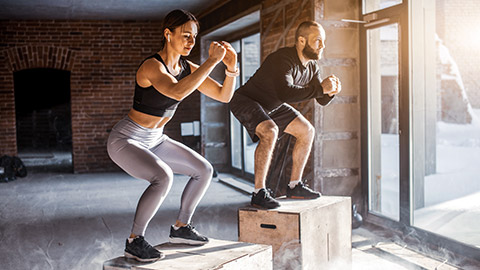
1. Squat
This is the most complex and compound movement which the body can perform. It is referred to as bilateral, which implies the movement is performed in unison, by limbs on both sides of the body. This movement targets muscles of the lower body such as the glutes, hamstrings, quadriceps along with the core.

2. Lunge
An unstable body movement which sees one foot further forward from the other, requiring greater balance, stability, and flexibility. This movement is referred to as unilateral, implying the limbs move independently of each other to produce the desired movement. Exercises can include, step up, and side lunges which target muscles of the lower body such as the glutes, quadriceps, hamstrings along with the core.
Fun fact, due to the stance of the lunge, all the glute muscles are stimulated to a greater degree than in a squat.

3. Push
A push movement can be performed in the horizontal & vertical plane, consisting of pushing a weight away from the body or the body away from a weight. This includes push-ups and shoulder presses. These exercises target the muscles of the upper body such as the chest, triceps, and the anterior shoulders.
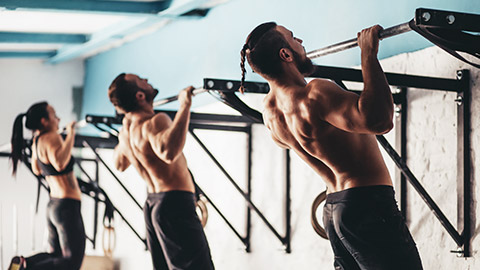
4. Pull
A pull movement can be performed in the horizontal & vertical plane, which is the opposite of a push, referring to pulling a weight closer towards the body or the hands. Using the large muscles of the back and upper body including biceps, forearms, lats, rhomboids and posterior shoulders. Examples include seated row, pull up or horizontal pull.

5. Twist
This is different to the others in regard to not being performed in the horizontal or vertical plane nor requiring movement forward or back, instead this action refers to trunk rotation movement performed within a turning or twisting fashion. This movement can be seen when throwing or kicking a ball, changing direction whilst running, passing an object as well as others. An essential movement in sporting success. Exercises which replicate this include the Russian twist, med ball twist and the woodchopper.

6. Bend
This also referred to as Hip Hinge- movement in which the glutes move back and the torse learns forward, maintaining a neutral spine, such as picking an object up off the floor, performing a deadlift type movement.

7. Gait
This term refers to the technique of walking. This fundamental movement pattern includes a combination of movements such as running, jogging, and jumping.
These basic exercise movement patterns are simple exercise classifications, which form the foundations of exercise selection in any program. As a fitness professional, it is essential to determine basic movement patterns that are essential for a client and then devise a range of exercises forged from those movement patterns (i.e., exercise classifications).
- Hip Hinge
- Hip Dominant
- Knee Dominant
- Vertical Push
- Vertical Pull
- Horizontal Push
- Horizontal Pull
- Rotational and Diagonal
- Anti-Rotation
- Anti-Flexion
- Anti-Extension
- Anti-Lateral Flexion.
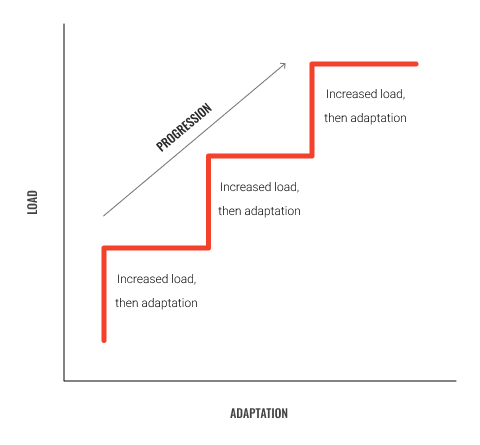
The staircase or overload principle of program design states that all programs should start slowly with a gradual increase towards the desired goal(s) with a positive and distinct difference between these two points. In order to produce a training effect, the body must be given time to adapt prior to increasing the stimulus or stressor. Designing the increase in load to occur too rapidly or be too large an overload can lead to injury and fatigue and therefore it is essential to consider when to introduce progression and by how much. This is to ensure safety and adherence to an exercise regime. When a program has reached its full potential, then a measurable positive difference in homeostasis will have been achieved and seen.
Within the overload principle, the up phase represents overload and physiological stresses being applied and the flat phase represents the recovery phase of a program that allows for full super-compensation, thus physiological adaptation, to occur.
The term periodisation refers to the division of a training program split into smaller, typically more manageable components with steps to meet the overarching goal. The concept of periodisation goes hand in hand with the GAS principle, providing a suitable stimulus (stress) at regular intervals with periods of phases to allow the body enough time to adapt before increasing the stimulus or introducing a new one. A well-designed periodisation program will avoid overtraining and promote successful and effective enhancements in performance.
Typically, periodisation of a program occurs when a program is of a minimum a year in duration, known as a macrocycle, which is then broken down into smaller components or phases which are referred to as mesocycles. The smaller components within each mesocycle are referred to as microcycles which are typically weeklong, within those are the individual work out sessions. The following image illustrates the flow of the cycles of periodisation.
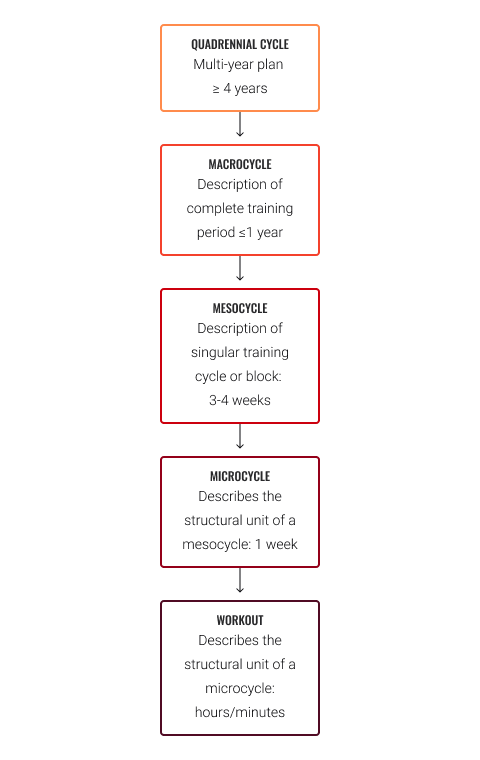
Periodisation follows the formula of progressive Physiological Stress + Recovery = Supercompensation/ Adaptation (i.e. a new level of homeostasis achieved). This requires the application of progressive physiological stresses i.e. acute training variables;
- Volume & intensity & weight
- Duration of exercise session
- Number of sets
- Total number of repetitions
- Rest periods
- Training mode(type)/exercise choice
- Frequency of training a body part/sessions per week or energy system
- Movement speed (velocity).
These align with the F.I.T.T principles:
Frequency: refers to the frequency of exercise undertaken or how often you exercise (per week)
Intensity: refers to the intensity of exercise undertaken or how hard you exercise (RPE, VO2max, HRmax, load, HR percentage)
Time: refers to the time you spend exercising or how long you exercise for (session duration)
Type: refers to the type (mode) of exercise undertaken or what kind of exercise you do, for example, circuit training, CrossFit, long slow distance, fartlek, High Intensity Interval Training (H.I.I.T) and hypertrophy training.
The following image illustrates an overview of the adaptation and progression principles that are required in order to achieve a successful and effective periodisation program.
The following table illustrates some of the differences achieved through periodisation versus a traditional program design.
| Marker | Periodized | Non-periodized |
|---|---|---|
| Lean muscle | +4.6lb (2.1kg) | +2.2lb (1kg) |
| Body fat % | -4% | -1.8% |
| Leg press | +44lb (20kg) | +18lb (8.2kg) |
| Bench press | +11.21lb (5.1kg) | +6lb (2.7kg) |
Periodisation based program design can take different forms such as:
- Linear
- Non-linear
- Reverse linear
- Block periodisation
Let us take a look at these in more detail below, including when would be appropriate to implement one model over another.
Linear periodisation
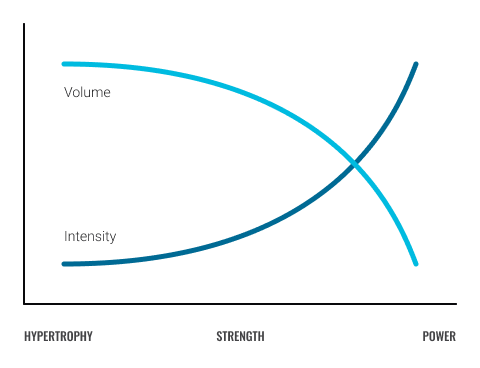
Typically, linear periodisation is considered to be the ‘traditional’ or ‘classic’ model of periodisation-based program design, named so as the model provides a linear increase in skills and performance at a steady state.
This model of training initially uses high volume and low intensity and progresses through mesocycles or phases where the volume decreases, and intensity increases. This style of training is broken down into phases that focus on hypertrophy, strength, power and transition phases which are also referred to as active recovery phases.
Each "mesocycle" is directed towards a single goal. Hypertrophy, for example, uses several sets of 6-12 reps, designed to stimulate growth. Strength builds on this hypertrophy and changes the reps to 1-6. Power finalizes this, using 6-8 reps. The Restorative phase drops volume or eliminates training entirely.
Why/when should you use Linear Periodisation?
- Linear periodisation is great for building a strong foundation, progressing in one variable, and working towards a peaking point.
- This programming style is useful for those who are newer to training
- Since linear periodisation is written for an annual training plan, it is easy to cater this training style to a slow progressive peak
- Most beginners need to build a strong foundation before they can try advanced training styles. Linear periodisation is a great way to slowly build a base without losing focus on what is important – building the foundation
- Athletes with short seasons who have one or very few competitions close to each other benefit with linear training. This allows a slow build-up to their peak or competition.
Non-linear periodisation
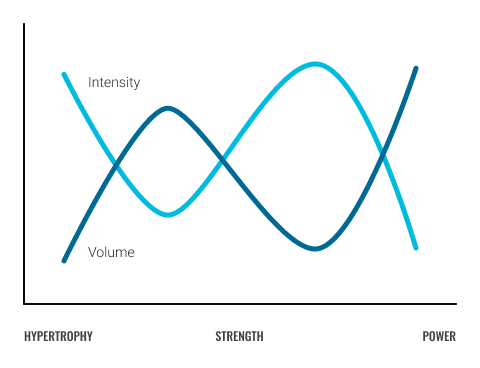
Non-linear periodisation is generally a periodised workout which is broken down into high intensity, low volume followed by high volume and lower intensity sections. Intensity (load) will wave up and down over a microcycle which can be within the same week or broken down into week blocks. In essence, non-linear periodisation relies on constant change in stimuli throughout training cycles to promote adaptation or maintain homeostasis.
Non-linear periodisation uses a constantly changing training plan with each microcycle, this allows for multiple components of fitness to be improved or maintained simultaneously and is best used during in-season as a way of maintaining multiple fitness components.
Non-linear program design should also follow after a regular linear program to be most effective.
Why/when should you use Non-linear Periodisation?
- Non-linear periodisation is an excellent way of individually training one variable and secondarily training others at the same time. It is often used for those with advanced training backgrounds and longer sport seasons
- Useful when someone who has a mature training age (2+> years) can benefit from the constant manipulation of variables for various training adaptations
- Athletes who have longer seasons will benefit by changing up variables more frequently
- By changing the focuses from something like hypertrophy to power, you can help prevent burnout within one variable, such as CNS fatigue from too much power training.
Reverse linear periodisation
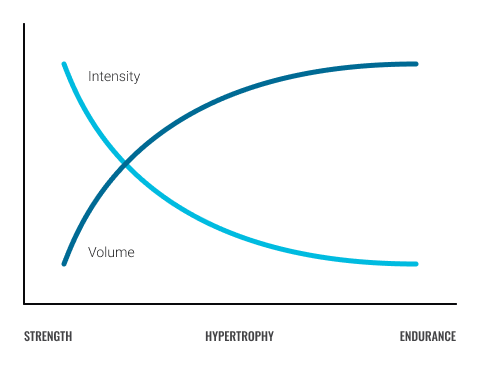
| Phase | Strength | Hypertrophy | Endurance |
|---|---|---|---|
| Sets | 3-4 | 3-6 | 3-6 |
| Reps/set | 2-6 | 8-12 | 15-30 |
| Intensity | High | Low | Very low |
| Volume | Moderate | High | Very high |
The goal of reverse linear periodisation is to emphasize an athlete’s muscular hypertrophy or endurance strength. The pattern of this style of periodisation generally starts with heavy weight for low reps, then progressively gives way to less weight and higher reps over several weeks or months.
Fun Fact - research supports the fact that reverse linear periodisation is more effective for increasing endurance strength than classic periodisation.
Example
Endurance athletes may use a reverse linear periodisation model as they need to improve local muscular endurance. Therefore, endurance athletes may build up to a greater number of repetitions over time instead of decreasing repetitions to increase strength.
Block periodisation
Each macrocycle is divided up into three distinct mesocycles. A mesocycle is a chunk of the training year that focuses on a specific goal. Each mesocycle is lined up in a specific order so that the results of the first mesocycle feed into the next in a logical pattern.
The goal behind these smaller, specific blocks is to allow an athlete to stay at their peak level longer. Since most sports have longer durations and call for multiple peaks, block periodisation is often prescribed. Within the training season, athletes will only focus on adaptations they need specifically for their sport, if an athlete does not need endurance, they will not train for it.
Why/when should you use Block Periodisation?
- Sports that require an athlete to peak multiple times during a season – also known as multiple competitions/games a year
- By frequently training specific training adaptations you work towards progressing in your sport with the variable you need, to avoid burning out
- When trying to maintain a high level of athleticism for competition over an extended amount of time
- The most important variable is accounting for the athlete’s needs and the rotation of blocks to allow optimal performance.
Periodisation is defined as the long term cyclic structure of altering variables in order to maximise performance. Put simply, this refers to the systematic, planned variations of the F.I.T.T principles. When designing a program to increase performance, it does not matter, when working under the principle of periodisation, at what point or phase of the training this is performed in as the overall goal is to maximise gains or improvement in performance whilst reducing the likelihood of injury and plateau within the training program. The term continuum implies a range or sliding scale between two extremes, with each point on the continuum slightly greater or lesser than its neighbour. This presents as a continuous sequence in which elements are side by side, whilst not being overly different from each other, but the extremes of the overall program will be quite distinct. For example, the four seasons of the weather, whilst we may notice gradual changes day to day, changing slowly over time, there are distinct differences in the weather of the four seasons. In a sporting sense, consider a new learner in a sport or a client wishing to advance their skills in a sport or activity, with activities and goals adapted to skill progression and scaled based upon factors such as basic skills and motor patterns to more complex varieties as development occurs. The following image illustrates the continuum of training and skill development.
Training cycles within periodisation
The following image provides a visual overview of an example breakdown of a periodised training plan, into its smaller components (cycles), over time.
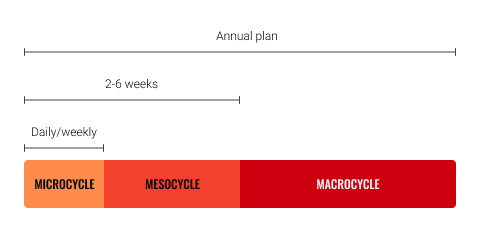
In this topic, we focused on the fundamentals of program design. You learnt about:
- Homeostasis and its relationship with program design
- Window of adaption
- Human performance curve
- Performance pyramid
- Fundamental movement patterns
- Staircase principle
- Models of periodisation
- Periodisation

